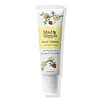What's inside
What's inside
 Key Ingredients
Key Ingredients

 Benefits
Benefits

 Concerns
Concerns

 Ingredients Side-by-side
Ingredients Side-by-side

Water
Skin ConditioningCitrullus Lanatus Seed Oil
EmollientSqualane
EmollientTriolein
Skin ConditioningMusa Sapientum Leaf Extract
Skin ConditioningGlycerin
HumectantBetaine
HumectantCetearyl Olivate
Butyrospermum Parkii Butter
Skin ConditioningCrambe Abyssinica Seed Oil Phytosterol Esters
EmulsifyingGlyceryl Stearate Se
EmulsifyingJojoba Esters
EmollientSelaginella Lepidophylla Extract
EmollientCetearyl Alcohol
EmollientCetyl Palmitate
EmollientSorbitan Olivate
EmulsifyingNicotiana Benthamiana Hexapeptide-40 Sh-Polypeptide-76
Skin ConditioningButylene Glycol
HumectantSalix Alba Bark Extract
AstringentGenipa Americana Fruit Extract
Skin ConditioningSorbitan Palmitate
EmulsifyingSorbitan Oleate
EmulsifyingXanthan Gum
EmulsifyingCitric Acid
BufferingWater, Citrullus Lanatus Seed Oil, Squalane, Triolein, Musa Sapientum Leaf Extract, Glycerin, Betaine, Cetearyl Olivate, Butyrospermum Parkii Butter, Crambe Abyssinica Seed Oil Phytosterol Esters, Glyceryl Stearate Se, Jojoba Esters, Selaginella Lepidophylla Extract, Cetearyl Alcohol, Cetyl Palmitate, Sorbitan Olivate, Nicotiana Benthamiana Hexapeptide-40 Sh-Polypeptide-76, Butylene Glycol, Salix Alba Bark Extract, Genipa Americana Fruit Extract, Sorbitan Palmitate, Sorbitan Oleate, Xanthan Gum, Citric Acid
Water
Skin ConditioningAloe Barbadensis Leaf
MaskingCetearyl Alcohol
EmollientPalmitoyl Tripeptide-38
Skin ConditioningCarthamus Tinctorius Seed Oil
MaskingGlycerin
HumectantCaprylic/Capric Triglyceride
MaskingNiacinamide
SmoothingPalmitoyl Dipeptide-5 Diaminobutyroyl Hydroxythreonine
Skin ConditioningGlyceryl Stearate
EmollientIsopropyl Palmitate
EmollientPhenethyl Alcohol
MaskingCaprylyl Glycol
EmollientEthylhexylglycerin
Skin ConditioningSodium PCA
HumectantSorbic Acid
PreservativeC10-18 Triglycerides
EmollientXanthan Gum
EmulsifyingArgania Spinosa Kernel Oil
EmollientPotassium Sorbate
PreservativeResveratrol
AntioxidantCocos Nucifera Oil
MaskingCitric Acid
BufferingCamellia Sinensis Leaf Extract
AntimicrobialUbiquinone
AntioxidantEuterpe Oleracea Fruit Extract
Tocopherol
AntioxidantCamellia Sinensis Extract
AntioxidantPunica Granatum Extract
AstringentCitrus Aurantifolia Peel Extract
CleansingWater, Aloe Barbadensis Leaf, Cetearyl Alcohol, Palmitoyl Tripeptide-38, Carthamus Tinctorius Seed Oil, Glycerin, Caprylic/Capric Triglyceride, Niacinamide, Palmitoyl Dipeptide-5 Diaminobutyroyl Hydroxythreonine, Glyceryl Stearate, Isopropyl Palmitate, Phenethyl Alcohol, Caprylyl Glycol, Ethylhexylglycerin, Sodium PCA, Sorbic Acid, C10-18 Triglycerides, Xanthan Gum, Argania Spinosa Kernel Oil, Potassium Sorbate, Resveratrol, Cocos Nucifera Oil, Citric Acid, Camellia Sinensis Leaf Extract, Ubiquinone, Euterpe Oleracea Fruit Extract, Tocopherol, Camellia Sinensis Extract, Punica Granatum Extract, Citrus Aurantifolia Peel Extract
 Reviews
Reviews

Ingredients Explained
These ingredients are found in both products.
Ingredients higher up in an ingredient list are typically present in a larger amount.
Cetearyl alcohol is a mixture of two fatty alcohols: cetyl alcohol and stearyl alcohol. It is mainly used as an emulsifier. Emulsifiers help prevent the separation of oils and products. Due to its composition, it can also be used to thicken a product or help create foam.
Cetearyl alcohol is an emollient. Emollients help soothe and hydrate the skin by trapping moisture.
Studies show Cetearyl alcohol is non-toxic and non-irritating. The FDA allows products labeled "alcohol-free" to have fatty alcohols.
This ingredient is usually derived from plant oils such as palm, vegetable, or coconut oils. There is debate on whether this ingredient will cause acne.
Due to the fatty acid base, this ingredient may not be Malassezia folliculitis safe.
Learn more about Cetearyl AlcoholCitric Acid is an alpha hydroxy acid (AHA) naturally found in citrus fruits like oranges, lemons, and limes.
Like other AHAs, citric acid can exfoliate skin by breaking down the bonds that hold dead skin cells together. This helps reveal smoother and brighter skin underneath.
However, this exfoliating effect only happens at high concentrations (20%) which can be hard to find in cosmetic products.
Due to this, citric acid is usually included in small amounts as a pH adjuster. This helps keep products slightly more acidic and compatible with skin's natural pH.
In skincare formulas, citric acid can:
While it can provide some skin benefits, research shows lactic acid and glycolic acid are generally more effective and less irritating exfoliants.
Most citric acid used in skincare today is made by fermenting sugars (usually from molasses). This synthetic version is identical to the natural citrus form but easier to stabilize and use in formulations.
Read more about some other popular AHA's here:
Learn more about Citric AcidGlycerin is already naturally found in your skin. It helps moisturize and protect your skin.
A study from 2016 found glycerin to be more effective as a humectant than AHAs and hyaluronic acid.
As a humectant, it helps the skin stay hydrated by pulling moisture to your skin. The low molecular weight of glycerin allows it to pull moisture into the deeper layers of your skin.
Hydrated skin improves your skin barrier; Your skin barrier helps protect against irritants and bacteria.
Glycerin has also been found to have antimicrobial and antiviral properties. Due to these properties, glycerin is often used in wound and burn treatments.
In cosmetics, glycerin is usually derived from plants such as soybean or palm. However, it can also be sourced from animals, such as tallow or animal fat.
This ingredient is organic, colorless, odorless, and non-toxic.
Glycerin is the name for this ingredient in American English. British English uses Glycerol/Glycerine.
Learn more about GlycerinWater. It's the most common cosmetic ingredient of all. You'll usually see it at the top of ingredient lists, meaning that it makes up the largest part of the product.
So why is it so popular? Water most often acts as a solvent - this means that it helps dissolve other ingredients into the formulation.
You'll also recognize water as that liquid we all need to stay alive. If you see this, drink a glass of water. Stay hydrated!
Learn more about WaterXanthan gum is used as a stabilizer and thickener within cosmetic products. It helps give products a sticky, thick feeling - preventing them from being too runny.
On the technical side of things, xanthan gum is a polysaccharide - a combination consisting of multiple sugar molecules bonded together.
Xanthan gum is a pretty common and great ingredient. It is a natural, non-toxic, non-irritating ingredient that is also commonly used in food products.
Learn more about Xanthan Gum